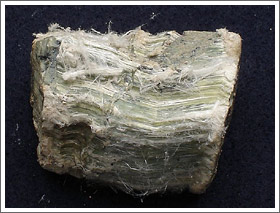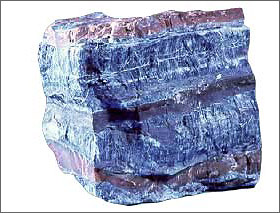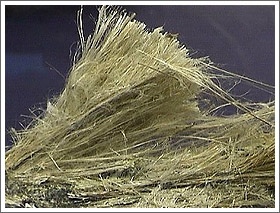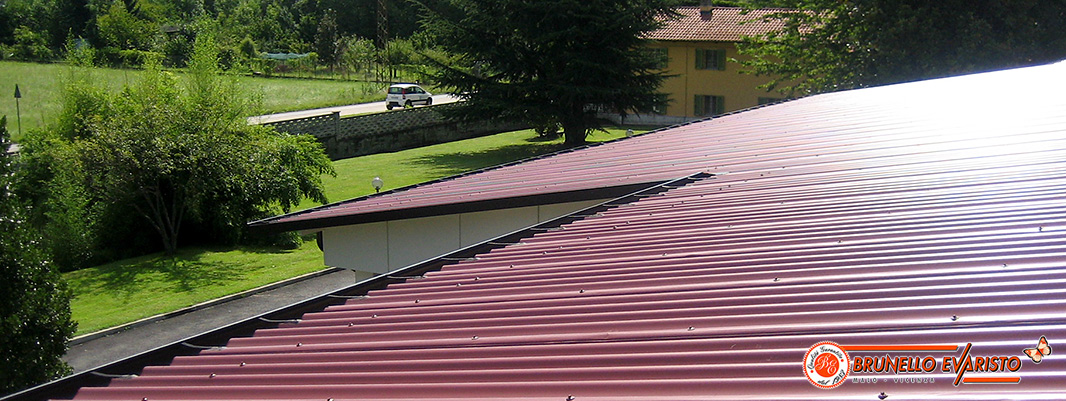Asbestos
Asbestos is extremely dangerous
to man’s health.
Asbestos from the Greek àsbestos, meaning "inextinguishable" or amianthus from the Greek amiantos meaning “incorruptible” is a silicatebased mineral that can separate into highly flexible fibers that are resistant to heat and chemically inert..
As its thermal insulating properties made it very desirable for building materials, asbestos was used extensively in the past in insulation and composite materials (asbestos cement). However, if inhaled asbestos fibres are carcinogenic. Today, as we are aware of the dangers of asbestos exposure, special precautions must be taken when removing and disposing of asbestoscontaining material.
Natural asbestos is found in two varieties:
SERPENTINE (curved fibres) Chrysotile (white amianto)
AMPHIBOLE (straight fibres) Anthophyllite, Actinolite, Amosite (brown asbestos), Crocidolite (blue asbestos), Tremolite.
Asbestos is a health hazard if its fibres are released to the air or become airborne and then inhaled. The human organs affected by exposure to asbestos are the lungs, the pleura, the pericardium and the peritoneum. Exposure to asbestos can cause a chronic lung disease or cancer called “asbestosis”, whereas “mesothelioma” is a form of cancer that affects the pleura.
Health risks from asbestos clearly increase with increased exposure, although some asbestos-related diseases can develop in people with only short-term exposure. Nonoccupational exposure to asbestos is a health risk as well; in fact, all persons residing, working or frequenting buildings constructed with asbestoscontaining materials are at risk, as fibers may be released and inhaled, and eventually penetrate the lungs.
The amphiboles, characterized by rigid fibres, are considered the most hazardous asbestos type. Past asbestos exposure still kills roughly one thousand persons each year. It is believed that this number will continue to increase over the next decade. There is usually a long latency period between exposure to asbestos and the onset of the disease. This can vary from 15 to 60 years. Asbestos-related diseases will only be wiped out when exposure to asbestos is eliminated or reduced to a minimum.
Main application for asbestos:
Fabrics: blankets, fire-retardant clothing, cushions, ropes, gloves, trivets, ironing boards, etc...
Sheets: seals, pipe insulators, cardboard, etc.
In loosely bound materials: wall panels, cladding for train carriages, etc...
In firmly bound materials: roof covering, tubs, piping, chimneys, seals, brake linings, vinyl sheet flooring, clutch facings, etc...
Since 1994, Italian Law 257/92 prohibits the use and sale of asbestos-containing materials.
Asbestos from the Greek àsbestos, meaning "inextinguishable" or amianthus from the Greek amiantos meaning “incorruptible” is a silicatebased mineral that can separate into highly flexible fibers that are resistant to heat and chemically inert..
As its thermal insulating properties made it very desirable for building materials, asbestos was used extensively in the past in insulation and composite materials (asbestos cement). However, if inhaled asbestos fibres are carcinogenic. Today, as we are aware of the dangers of asbestos exposure, special precautions must be taken when removing and disposing of asbestoscontaining material.
Natural asbestos is found in two varieties:
SERPENTINE (curved fibres) Chrysotile (white amianto)
AMPHIBOLE (straight fibres) Anthophyllite, Actinolite, Amosite (brown asbestos), Crocidolite (blue asbestos), Tremolite.
Asbestos is a health hazard if its fibres are released to the air or become airborne and then inhaled. The human organs affected by exposure to asbestos are the lungs, the pleura, the pericardium and the peritoneum. Exposure to asbestos can cause a chronic lung disease or cancer called “asbestosis”, whereas “mesothelioma” is a form of cancer that affects the pleura.
Health risks from asbestos clearly increase with increased exposure, although some asbestos-related diseases can develop in people with only short-term exposure. Nonoccupational exposure to asbestos is a health risk as well; in fact, all persons residing, working or frequenting buildings constructed with asbestoscontaining materials are at risk, as fibers may be released and inhaled, and eventually penetrate the lungs.
The amphiboles, characterized by rigid fibres, are considered the most hazardous asbestos type. Past asbestos exposure still kills roughly one thousand persons each year. It is believed that this number will continue to increase over the next decade. There is usually a long latency period between exposure to asbestos and the onset of the disease. This can vary from 15 to 60 years. Asbestos-related diseases will only be wiped out when exposure to asbestos is eliminated or reduced to a minimum.
Main application for asbestos:
Fabrics: blankets, fire-retardant clothing, cushions, ropes, gloves, trivets, ironing boards, etc...
Sheets: seals, pipe insulators, cardboard, etc.
In loosely bound materials: wall panels, cladding for train carriages, etc...
In firmly bound materials: roof covering, tubs, piping, chimneys, seals, brake linings, vinyl sheet flooring, clutch facings, etc...
Since 1994, Italian Law 257/92 prohibits the use and sale of asbestos-containing materials.




